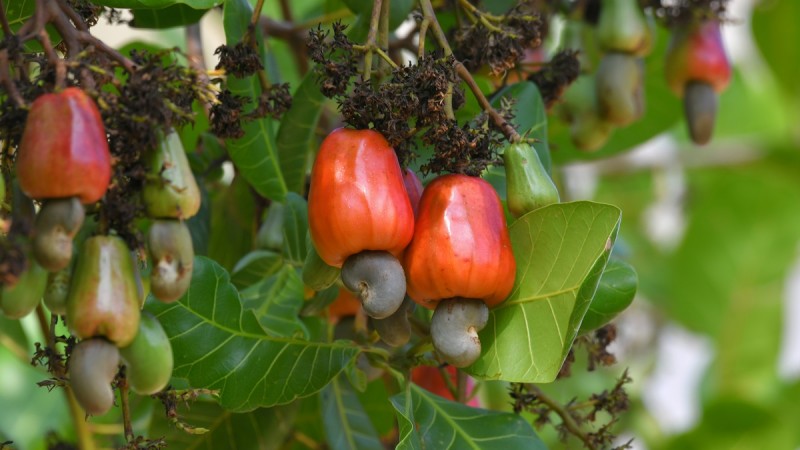Cashews: tariffs partly to blame for new trade dynamics
May 22, 2025 at 10:30 AM ,
Der AUDITOR

Global production 2% down
Raw cashew nut production is projected 1% lower than in 2024/2025 in the Northern Hemisphere and 2% higher in the Southern Hemisphere. Total production will range 2% lower.
Côte D’Ivoire will maintain its position as leading producer in 2025/2026 as output is expected to rise by 4%. Crop sizes have in fact nearly doubled in the past nine years. While production still stood at 650,000 mt in 2016, estimates for this year range at 1.25 million mt. This strong growth is actively supported by the government, which has also improved rural infrastructure and highway connections. In addition, farmer training programmes and investments into cooperatives have strengthened supply chains. Cultivation has, in addition, expanded from northern regions to central ones. At the start of the season the government imposed temporary export restrictions for raw cashew nuts to support local processors.
By contrast, production in Cambodia will fall 4% short of 2024/2025. Issue is that cool weather conditions prompted the crop to be late. Although arrivals were slow in March, this changed in April with arrivals outpacing last year. At present cashews are grown on 633,000 ha. Expectation is that land availability will grow, only downside is that cashews face competition from cassava and rubber. The long-term outlook is positive as production should rise with more plantings bearing fruit and trees maturing. Cambodia is the most important supplier for Vietnam.
India accounted for 14% of global RCN production in 2024, but only 5% of exports as consumption is quite high with a share of 31% in the global market. India will need to increase production to maintain this demand and its share in the international market. This year’s production will rise by 18%.
Local media have recently highlighted Tanzania’s success as leading agricultural exporter in East Africa. Although present estimates suggest that the 2025/2026 crop, which will only be harvested in September, will be similar in size to 2024/2025, output has risen sharply in the past four years along with farmgate prices as the government has placed strategic initiatives.
Unseasonal rains have impacted the 2025 crop in Vietnam, the world’s leading RCN processor. Anticipation is that this year’s crop will range 10-15% lower than last year. The country’s domestic crop only accounts for 8-10% of processing and the outlook is far from promising with no increases in sight as older trees are being replaced by new varieties with urbanisation, other crops and climate change presenting enormous challenges.
|
Global raw cashew nut (RCN) production (mt) |
|||
|
Country |
2024/25 |
2025/26* |
Diff. |
|
Côte D’Ivoire |
1,200,000 |
1,250,000 |
4.2% |
|
Cambodia |
800,000 |
775,000 |
-3.9% |
|
India |
615,000 |
725,000 |
17.9% |
|
Vietnam |
340,000 |
300,000 |
-11.8% |
|
Nigeria |
282,000 |
275,000 |
-2.5% |
|
Guinea-Bissau |
240,000 |
250,000 |
4.2% |
|
Ghana |
275,000 |
225,000 |
-18.2% |
|
Benin |
250,000 |
220,000 |
-12.0% |
|
Guinea Conakry |
145,000 |
125,000 |
-13.8% |
|
Burkina Faso |
145,000 |
125,000 |
-13.8% |
|
Senegal |
45,000 |
60,000 |
33.3% |
|
Togo |
105,000 |
50,000 |
-52.4% |
|
Gambia |
25,000 |
25,000 |
0.0% |
|
Mali |
2,000 |
5,000 |
150.0% |
|
Subtotal |
4,469,000 |
4,410,000 |
-1.3% |
|
Tanzania |
425,000 |
425,000 |
0.0% |
|
Brazil |
150,000 |
150,000 |
0.0% |
|
Indonesia |
93,000 |
100,000 |
7.5% |
|
Mozambique |
90,000 |
95,000 |
5.6% |
|
Kenya |
5,000 |
5,000 |
0.0% |
|
Subtotal |
763,000 |
775,000 |
1.6% |
|
Total |
5,288,600 |
5,210,000 |
-1.5% |
|
INC May 2025 |
|||
New trade dynamics emerging
Although 2024 was highly challenging for the entire supply chain as El Niño impacted the West African crops, Côte D’Ivoire suspended RCN exports and shipments were delayed, Vietnam completed a highly successful export year. Issue is that the country could draw on good crops from Cambodia in the early part of the year and from Tanzania in the latter part. Cambodia and Côte D’Ivoire supplied 50-60% of Vietnam’s RCN imports in 2024 with projections stating that the share from Cambodia will increase, whereas the share from Côte D’Ivoire will decrease. As the total number of RCN imports has, however, declined Vietnam’s carry-over stocks are speculated to be the lowest on record for 2025.
With local processing on the rise in Africa much is at stake for Vietnam’s industry. INC projections state that local processing will reach 500,000 mt in Côte D’Ivoire in 2025 and has surged by an impressive 750% between 2016 and 2024. The country is actively investing in support schemes and programmes for local processors along with smoother logistics and infrastructure and early access to domestic RCN production. For buyers it will pay to look to Africa for kernels in future.
Opportunities to purchase sustainable cashew kernels are also in place in Cambodia. Although the will is there to step up local processing, incentives are, however, far less ambitious. Processing capacity only ranges at 15% of the crop. For Vietnamese buyers it makes more economical sense to shipp RCN to their own country as power costs are higher in Cambodia and the labour force less productive. Other South-Asian companies from Taiwan or Japan are, however, showing a strong interest. China has already invested heavily in Cambodia and most cashews from here are, in fact, shipped to China.
Growing demand in China vs. US tariffs
Cashew kernel imports from Vietnam to China also reached a record 115,000 mt in 2024. On top of this, the country purchased around 8,000 mt in Africa. Not only is demand on the rise for snack innovations in China but cashew prices are also relatively attractive as compared with other tree nuts. In addition, the uncertainties concerning the trade relations with the US have also rendered cashews more attractive.
Vietnam’s exporters have cast a nervous eye on the USA as the leading consuming market for cashews. Issue is that Trump announced a 46% import tariff for Vietnamese products in April. They have fortunately been globally suspended until July as Reuters reports. At present, a 10% tariff is in place and negotiations will continue in June. This uncertain trade climate has prompted US importers to move shipments forward and to suspend new orders in Vietnam as traders state.
View more
- price chart, cashew kernels, W320, India
- price chart, cashew kernels, W450, India
- price charts for nuts, dried fruit, oilseeds, spices and more





